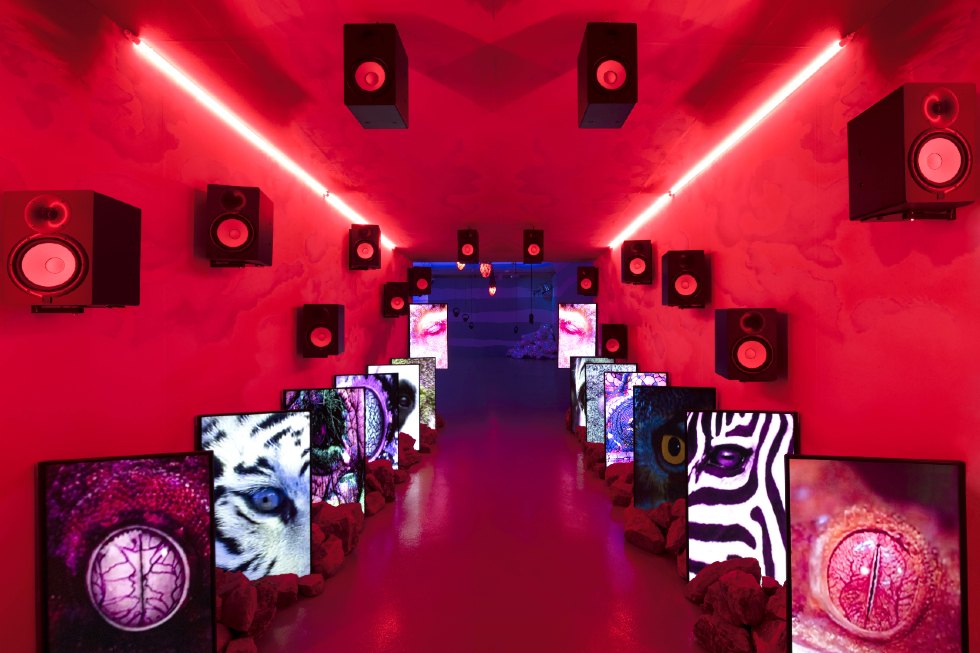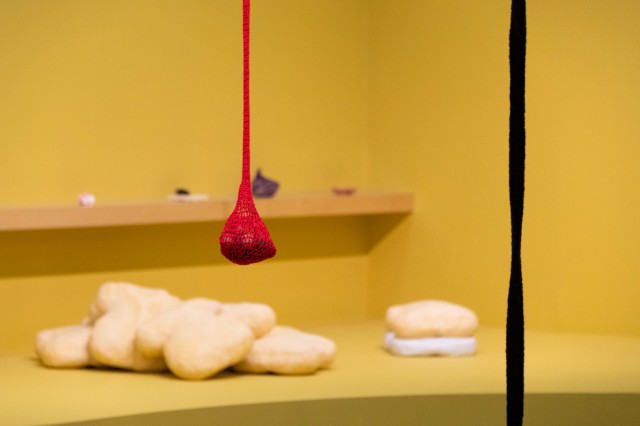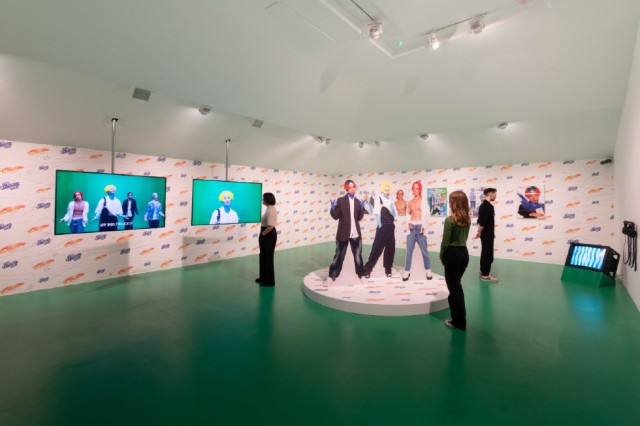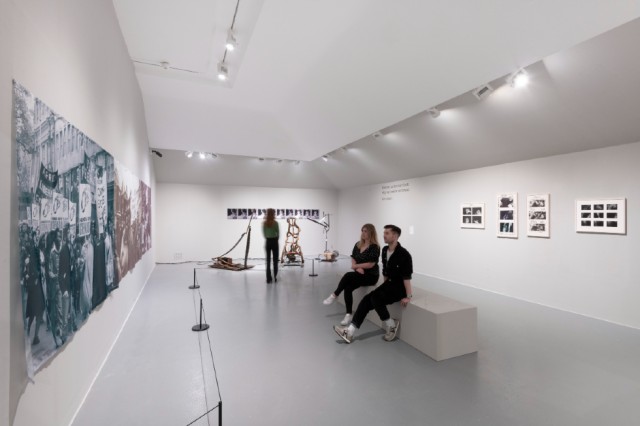“Exhibition at the end of the world”: Turner Prize 2022 – Reviewed

Laura Robertson on the UK’s biggest contemporary art prize: back in Liverpool, once again, and lingering in the mind long after you’ve left Tate…
Welcome back, Turner Prize! The conversation-starting exhibition rarely leaves London, yet here it is again in Liverpool for the second time in fifteen years, and with free tickets to-boot. A cause for celebration in itself, if you are to think about the city’s transformative title as European Capital of Culture in 2008. In 2007, I was at Tate Liverpool for a Turner Prize which saw Mark Wallinger (wearing a bear suit) win. The city’s taxi drivers were trained as art critics that year, and a Black Cab was parked in the gallery, screening (on the back seat) critical debate with passengers.
It was a bizarre, thrilling experience, as is Turner Prize 2022. It is a show so dynamic, so full of deep readings, mood swings and fluctuations of energy, I need a beer afterwards to decompress. It’s a wild ride: one that feels apt and right for the UK we are living in today. I’m surrounded by people in the gallery, of all ages: pensioners and kids alike, staring, rapt, at fake breasts and images of protest, examining tiny sculptures and listening to booming sound art. Generous and clear in its messaging of current ideas, issues and politics, this Turner Prize will reward multiple visits.
I’ll start with the artist who I think should win: Ingrid Pollard. All four shortlisted artists – Pollard, Heather Phillipson, Veronica Ryan and Sin Wai Kin – have very strong points of view, are relevant and contemporary, and provocative in their own ways: traits we’ve come to demand from the annual award. So how to choose a winner out of four worthy ones? Well, Pollard feels like an artist at the top of her game: the show here (based on Carbon Slowly Turning at MK Gallery, which was her first full retrospective of a practice spanning 40 years) is multi-layered, expertly researched, and plays with techniques and processes beyond the photography she is so well-known for. Crucially, for me, Pollard’s selected work packs a gut-punch, lingering in the mind long after you’ve voted for your favourite (there are tokens provided at the exit, and slotted perspex boxes, one for each artist) and left the gallery.
But back to Pollard later, who closes the show. Opening the Turner Prize with a howl, quite literally, is Heather Phillipson’s RUPTURE NO.1: blowtorching the bitten peach (first exhibited at Tate Britain in 2021). Apocalyptic and bonkers, it feels like an exhibition at the end of the world: we are watching species soon to be extinct, from a planet in death throes, that we are destroying. Like robots, we stand in rows, put on headphones that dangle from the ceiling, and plug ourselves into a soundtrack of ominous weather forecasts (“I thought the world was everything… Your life depends on it… The temperatures are beginning to rise…”).
There’s always a silliness, an absurdity, undercut by the unsettling or uncanny in Phillipson’s work that I love (think the ‘eggsyrub’ installation in London Underground, or her fly-in-cream Fourth Plinth sculpture, or the smear test film). The ludicrousness and irrationality of destroying your own habitat is quite plain –our world, as Phillipson suggests, is on fire. At the door, sands around something resembling a bomb shelter are illuminated by the peach of the title, masquerading as the setting sun.

Veronica Ryan’s room abruptly forces you to slow down. You step from chaos into a space full of ‘do not touch’ fragile objects on plinths (with some lingering aural bleed-through from the previous room): a sickly yellow display of tiny sculptures, intricately and expertly cast from plaster, crocheted, stitched and wrapped in twine. This work was made on residency at Spike Island and exhibited as Along a Spectrum in 2021. Initially, I wondered why Ryan’s room hadn’t been soundproofed, designed into the final spaces of the exhibition; perhaps even providing us with spaces to sit, lie down or touch quilted and padded materials.
But this is not a calming space. Do not get too comfortable. It put me in mind of Charlotte Perkins Gilman’s short story, The Yellow Wallpaper, about a convalescing woman who sees patterns on the walls in the bedroom of her new house, and is driven mad. As soon as you read what these fragile things are called, the room suddenly becomes incredibly disconcerting. A neck pillow made from plaster and netting is transformed from harmless to gross, with the title Infection III (2020). Suddenly, you’re taken back in time, into lockdown, and this pleasurable sensation of tactility you receive from looking at the handmade turns into a fear of touch, and what that may lead to: illness or death. In these intelligent acts, Ryan reminds us of what we’ve lost and what we’ve gone through.
Sin Wai Kin’s world is existential and life-affirming: one of pop culture, Chinese philosophy, and poems about the universe and what it means to live in it. A dreamy boyband performs on screen in the first room, gently singing “It’s always you” – much like a love song sang to the mirror. Boyband-branded wallpaper and posters of each member – The One, Wai King, The Universe, The Storyteller – makes for a teenage giddiness which is joyful and reflective in tone.
Shortlisted after being featured in the touring British Art Show 9 exhibition in 2021 (a similar celebration of British contemporary art now, which often influences the Turner nominees), Sin plays multiple characters. You might have seen their work as Victoria Sin, represented here in framed, Turin Shroud-like make-up wipes bearing flamboyant imprints of lipstick and eyeshadow (Taking off the Construct day 1, 2 & 3, 2021). They, we, ask: who am I? I thought about the manifestation of our different selves, distinctive ‘constructs’, that can emerge at any given time in our lives. What do we say to others in our actions? What do we say inwardly, to ourselves, as a way of understanding who we are, as self-awareness, as self-criticism?

Coming full circle, Pollard’s show is horrifying in comparison. The artist gives us space to think about the image of Africa as seen through British eyes, as believed through the fiction, caricatures and cartoons lingering post-Empire (Seventeen of Sixty-Eight, 2019). Pollard’s landscape and documentary photographs of real pub and street signs from around the UK – Black Boy, Black Boy Inn, Black Boy Wood – are collected here alongside extracts from books, a film of a dancing Black marionette, and the wooden signs themselves, as well as embossed prints stark in their whiteness; as raised white letters on thick white paper, illustrating the bare outlines of Black men and boys depicted at stereotypical labour, at work in fields, in turbans, in the foreground of palm trees. It is an archive of racism. Literature is utilised to deepen communication, as with the quote from Maya Angelou stuck high up on the wall (‘Now you understand. Just why my head’s not bowed’).
In Pollard’s work, these patterns of pain keep repeating themselves. Her kinetic sculptures bow down and very low, as their title suggests, again and again. It’s agonising for them to do so, and awful to watch. They shriek, scratch and scrape, fall and stumble forward. One sculpture, made of thick ropes, has a horrible, flopping body language; in another, two rusty saws rub together like locust legs; the upright one with a baseball bat (imbedded with glass and apparently found in the woods by Pollard) shakes its head from side to side, in a ‘no’ gesture, wheels squeaking. Other works are evidence of subjugation and dissent: the holographic prints of an endlessly curtseying Black child dressed in Sunday best (Bow Down and Very Low-123, 2021); of demonstrations, printed on voile and hung like banners on the wall (called No Cover Up, 2021, showing banners of ‘Hands off Grenada’, ‘Ban Racist Reporting’; ‘Total Eclipse of The Sun’), of verbal abuse and rejection (DENY: IMAGINE: ATTACK: SILENCE, 1991/2019).
Bring the Turner Prize back to Liverpool every year, please, and in-case you couldn’t guess at my vote: Ingrid Pollard to win.

Laura Robertson
See the Turner Prize 2022 at Tate Liverpool until 19 March 2023 – FREE entry
Image credits, from top:
Turner Prize 2022: Heather Phillipson: Rupture No 6: biting theblowtorched peach. Installation View at Tate Liverpool 2022. Photo: © Tate Photography (Matt Greenwood)
Turner Prize 2022: Veronica Ryan. Installation View at Tate Liverpool 2022. Photo: © Tate Photography (Matt Greenwood)
Turner Prize 2022: Sin Wai Kin: It’s Always You. Installation View at Tate Liverpool 2022. Photo: © Tate Photography (Sonal Bakrania)
Turner Prize 2022: Ingrid Pollard: Bow Down and Very Low–123, DENY: IMAGINE: ATTACK: SILENCE, No Cover Up. Installation View at Tate Liverpool 2022. Photo: © Tate Photography (Sonal Bakrania)





